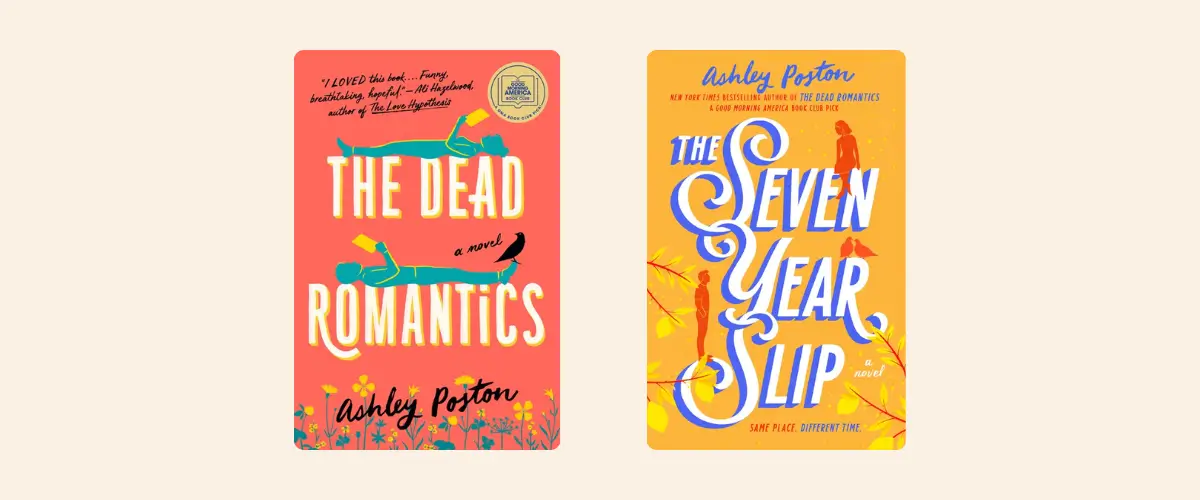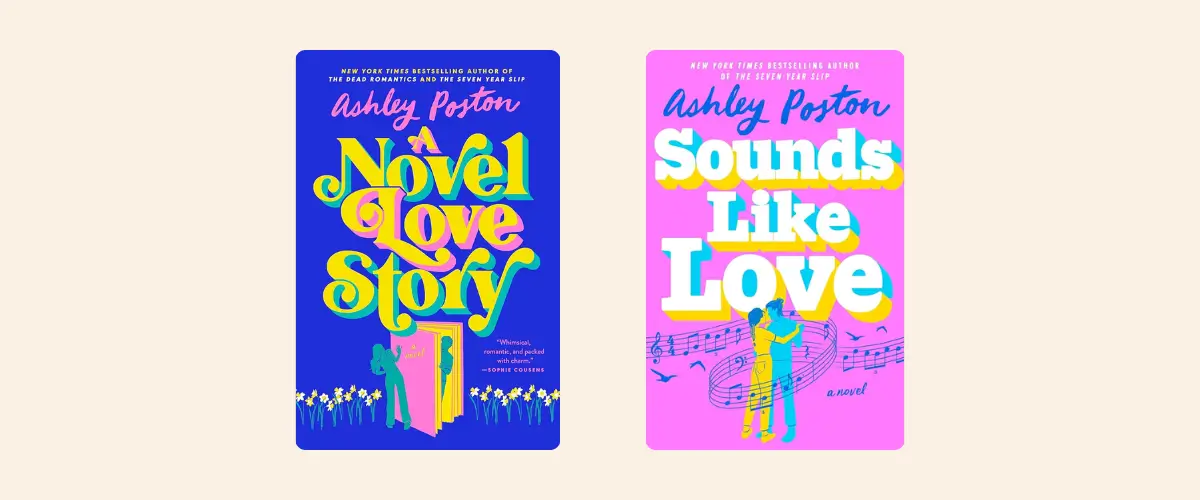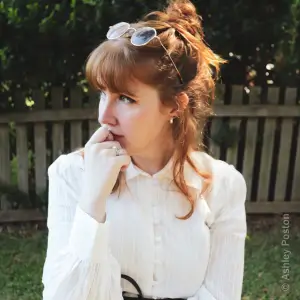Most romance novels focus upon a connection that feels magical, ordained by the cosmos, fated to be. In the classic romance genre, this connection is grounded by the laws of the earth, feeling magical but remaining realistic. In speculative romance, however, our love interests can defy these earthbound laws; they can be witches, fairies, ghosts, elves... You name it. Transcending the boundaries between the real and the fantastical, they can spark an epic romance that is genuinely and thrillingly magical.
So, are you wondering how to write your own romantic story with a magic sparkle of something otherworldly?
Your guide to speculative romance is here, provided by Ashley Poston, the bestselling author of five romance novels and champion of the hot ghost boyfriend trope. As we approach the season of sweethearts, use this five-step guide to illuminate your path (perhaps by the light of the moon?) toward your very own speculative romance, or use it to get into the spirit of Valentine’s Day and add some passion-packed books to your TBR.
Taking ‘ghost’-writing to a whole new level, Ashley Poston’s New York Times bestselling novel The Dead Romantics tells the story of a writer who falls for her editor—who, frustratingly, happens to be a ghost. Ashley is also the author of The Seven Year Slip and 2024’s A Novel Love Story, and her newest novel, Sounds Like Love, will be published in the summer of 2025. A TikTok sensation and leading voice of the romcom genre, Ashley Poston follows her live writing class for The Novelry with this guide to writing a romance with a little magic.
.webp)
Ashley Poston’s five ingredients for a speculative romance
Readers often tell me, ‘I didn’t think I’d like a ghost story!’
While I can’t relate (I’ve always been a sucker for Devon Sawa in the 1995 classic Casper), I can understand the sentiment. Often, as readers, we gravitate toward the kinds of books we already like—whether it be historical or fantasy or thriller, genre or literary. There’s a safety in knowing exactly what we’re getting into, and—no offense to all those other genres—we’ve all been burned before when we’ve branched out into something new.
So, to say it fills me with joy whenever a reader tells me in a hushed whisper, ‘I’ve never read time travel before!’ is an understatement. I’m so glad they took a chance on a story they weren’t sure they’d like. It’s really my favorite thing, along with ‘I didn’t think I’d like romance!’
And then they usually lean toward me and ask, ‘How did you do it?’
So, how did I do it?
The easy answer is that I just sat down and wrote the story I wanted to read, and for the most part, that’s true. I was raised on fan fiction and a healthy dose of fantasy and supernatural romances, so I found out very quickly on my reading journey what I liked versus what I didn’t. You would think that’d make it much easier for a 15-year-old to browse her local bookstore with 20 dollars in her pocket and one chance to find a book that sings to her. But the sad truth is, it did the opposite.
Because the things I liked in books weren’t a certain genre—they were tropes, archetypes, and themes. Some of them are hallmarks to particular genres, of course, like Only One Bed or Boning on Dragons, but the books I liked best were the ones that pushed those boundaries. I liked the ones that played in another genre’s sandbox, reimagining tropes and archetypes into things I’d never read before.
So, I read widely. I discovered new ways to tell old stories, and slowly, book after book, I started to learn how to write my own.

1. Find the whimsy
Start with a plot, a genre, a character or two. Find what makes the story move—my editor, Amanda Bergeron, calls this the ‘engine’ of the novel. Explore who your characters are and what they need. In a romance, the characters in question need to be foils for each other. They each have to teach the other something about the world—and about themselves—that they cannot learn on their own.
Romance 101, really.
Then where does the whimsy come in?
When I craft a new novel, I focus on the characters. When I have their arcs set up and the plot (mostly) solidified, I start to think about the whimsy of the story. If two characters are foils for each other, what is the foil made of?
That is where I add the whimsy.
2. Create an almost-possible magic
Now that I know where to put the whimsy, what does it look like? The sky’s the limit, really, as long as I can make it (somewhat) believable. By that, I mean: if the characters can believe it exists, then I can convince the reader that it might, too. (Or at least convince the reader that it’s possible in the magic world of this novel.)
For instance, in The Dead Romantics, Florence Day is a ghostwriter for a very famous romance novelist. (Real world. Grounded.) She can also see ghosts. (Speculative!) When she finds herself haunted by the ghost of her very hot—and very recently deceased—editor, she begins to realize that the prospect of romance might not be as dead as she once thought. The whimsy is supernatural.
In The Seven Year Slip, Clementine inherits an apartment from her late aunt, only to find a tenant already living there (grounded and mysterious!)—one who lives seven years in the past. (Womp, womp.) By focusing on the real, believable connections Clementine has with the reader—the notes of grieving a loved one, of feeling stagnant in her day job, of terrible luck in love—the time-travel magic of the apartment becomes the vehicle through which she explores her feelings and finds herself in love.
For A Novel Love Story, the whimsy was the easiest out of all of them. If you’ve ever visited the Hudson Valley in New York, you know how easy it is to get lost in a little town and never want to leave. (Can confirm. Have done this on multiple occasions.)
Sometimes, the world just gives you magic, and you run with it.
{{blog-banner-7="/blog-banners"}}
3. Nurture the heart of the romance
Now that you have your character foil and your whimsy, find out how they work with each other. Lean into the tropes that personify the whimsy in question. While my books are stalwartly romances, I like trying to find ways to combine my favorite romantic moments—the meet-cutes, the dark nights of the soul, the grand romantic gestures—with my favorite tropes and elements of whatever bit of whimsy I’m using as the foil.
In The Dead Romantics, I adore the idea of yearning. Of wanting to touch someone so badly, but you can’t. I crafted the world-building of what ghosts could and couldn’t do after this single idea. So, Florence can see Ben, but she can’t touch him, and vice versa. He also can’t possess people. I wanted them to want to be together so badly they ached, and I used the speculative element of the story to do that.
For The Seven Year Slip, I knew I wanted Clementine to meet Iwan in the present while she’s finding herself drawn to the version of him in her magic apartment who is seven years in the past. I wanted that dichotomy of him knowing what exactly is going to happen to them and not telling her—and letting it happen because the idea of not knowing her at all is more painful. (Spoilers, he’d say.) There’s this delicious tragedy in that, which I wanted to explore.
And in A Novel Love Story, I wanted to write about falling in love with a man who doesn’t exist, because we’ve all been there as romance readers. Being head over heels for a book boyfriend only to get to the end of the novel and remember that he doesn’t exist. I wanted that feeling physically—of having to not only close a book but to walk away. Deciding to face real life instead of a magic fantasy. I needed that moment—where Elsy chooses herself, and hopes that someday someone will choose her, too.
4. Ground it with a thread of reality
One of the final—and trickiest—bits about writing these books is how to ground them. This is different than creating almost-possible magic. This part isn’t what ties the story to the romance genre—to contemporary romance, in particular—but what ties the story to the reader.
This is how you use the foils you’ve created to connect with the person reading the book. If you’ve done the other things, this part comes naturally. It’s baked in.
The Dead Romantics is a ghost story, but what grounds it—what connects it—is a story about saying goodbye and moving on. And what better way to form that connection than through a ghost story?
The Seven Year Slip is a time-travel story, but what readers gravitate toward is Clementine’s passage through her grief and how to reckon with the person you once were and the one you want to be. What better vehicle to tell that through than time travel?
A Novel Love Story is a portal fantasy. (Whoa, plot twist!) Elsy feels like a secondary character in her own life, so what better place to explore that journey than in the book series she’d give anything to live in?

5. Finish the book
This feels obvious, but it’s a step, nonetheless. It takes time, effort, and dedication to finish a book. It’s probably the hardest thing you’ll do. Coming up with ideas, plotting them out, creating a schedule of 2,000 words a day to hit your goal—that’s easy in comparison.
Because what I mean by finishing a book is not typing THE END when you get to the last page of your first draft. I mean finishing it. Setting it aside for a week (or a month) and coming back to your story and writing it again.
Writing it better.
You won’t finish a story in one draft—if you think you did, go back and rewrite it.
(I know there are caveats. Some authors go back and rewrite each chapter as they finish them. They spend days worming over a single sentence. I see you, and I commend you. I also don’t consider that finishing a book in one draft. That’s a thousand little drafts in a trench coat.)
Most importantly, write the things that make you happy. The things that make your heart sing. Don’t write to the market. Don’t write to chase a trend.
Write to start one.
Welcome home, writers. Join us on the world’s best creative writing courses to create, write, and complete your book. Sign up and start today.



.avif)
.webp)

.webp)